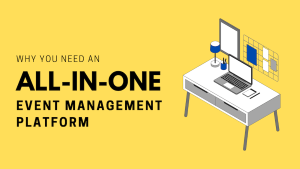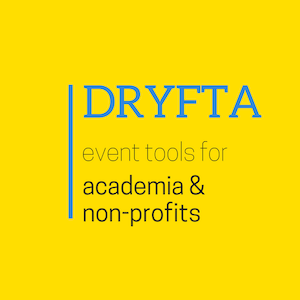
It’s easier than ever to create an event website. You’ll find several design templates and other tools available online to start building awareness of your event while providing an attractive destination that’s responsive and easy to navigate.
Before you can finalize your event website, several crucial factors must be considered if you want the site to communicate effectively with each visitor. Once you’ve secured the appropriate processes and tools for building your online presence, it helps to know how to use them appropriately.
This guide will take you through what you need when you want to know how to create an event website.
Processes Required to Design an Event Website
When you’re ready to create an event website, it’s essential to consider several design elements and processes. That begins with knowing your audience.
Identifying the audience for your event is more complicated than reaching out to people who want to find more information about it. You’ll want to ask yourself the following questions.
- Is the event website meant to generate interest, or is there a purchase intention that needs to get built into it?
- Are there subcultures with common motivations that require specific messaging?
- Is the typical visitor a supporter or a decision-maker?
Conducting market research, analyzing competitive events, or defining who isn’t in your target audience makes it easier to refine the website’s message.
Once you’ve completed that process, you’ll be ready to examine these additional areas for your event site.
Processes to Follow When Designing an Event Website
| Key Design Processes | Why These Design Processes Are Important |
| Branding Needs | Event attendees should recognize your brand the moment they reach a landing page. Uniformity is what delivers results in this area, including fonts and colors. People tend to look at the top left of their screen before reviewing information in a horizontal F-shape motion. |
| Design Simplicity | As eager as you are to show off the best elements of an event, you can overwhelm people by delivering too much information. Give visitors the essentials they need to know on the first home or landing page. Data about sponsors, venues, speakers, artists, and more can go on deeper dedicated pages. |
| Content Creation | Visitors keep coming back when you have valuable information to offer. Consider starting a blog with your event website to deliver this resource. You could even use that design element to provide speakers or notable attendees a place to discuss what to expect. |
| Responsiveness | A majority of Internet traffic comes from mobile devices today. With a responsive event website design, the coding automatically recognizes what someone uses to access your information to maximize how the information displays on a screen. |
| Keyword Optimization | Today’s keyword inclusions should appear naturally within your content. If you force things by using terms or phrases that don’t seem to belong to the casual visitor or a search engine crawler, your posts and pages could look unprofessional. |
| Page Design | Designing pages to be quickly scannable can be an asset when creating an event website. People look for key moments right after a page loads, including subheadings, bullet points, and tables. Instead of putting together huge text blocks, think about how you can break things up to highlight your best features. |
| Precise Descriptions | An event website should include a clear description of what the event is about and when to attend. This information should be short and to the point. Be specific about the time, date, and venue to eliminate any potential confusion. As part of the call to action, consider how people can RSVP to ensure their attendance. |
What Are the Tools Needed to Build an Event Website?
Regardless of the size of your event, you’ll always generate more awareness with the publication of a relevant and informative event website. With the number of tools available today, it’s easier than ever to create one yourself.
Here are the best tools to use to start building a new event site from scratch.
1. HTML / Text Editor
HTML stands for “Hypertext Markup Language.” It’s the primary computer language used to create websites today. Although you don’t need to be a skilled programmer to build a site, it helps to know a little about HTML5 basics.
Several free online websites deliver comprehensive information about HTML so that you can get started on your design, including HTMLGoodies and W3Schools.
You can also find HTML editors that streamline the web page creation process with features like tag completion. For basic coding, a simple text file program like Notepad is useful.
If you want professional tools for your HTML and text editing, examples like Komodo IDE and Adobe Dreamweaver can speed up the coding and debugging work you’ll be doing. These tools often highlight errors and auto-complete common tags, making them worthwhile investments.
2. Image Editor
Event websites benefit from having eye-catching visuals published on each post and page. That means you’ll need the images to fit specific sizes without slowing your loading time. For most sites, the standard resolution for display is 72 DPI (Dots Per Inch).
Depending on the use of large files or thumbnails, the size can range from 640 x 480 pixels to 100 x 75 pixels.
Most event websites don’t need to max out the dimensions and DPI to create a powerful first impression. By resizing your images to fit, you can keep the bandwidth high.
An image-editing tool can help you convert or crop your pictures to reach the appropriate size. Most computers and operating systems come with free software that takes these steps. If you prefer an online tool, BeFunky provides several no-cost options to consider, along with a pro plan that unlocks even more resources.
You can also use professional tools like Photoshop to create results. If you need logos or buttons on your event website instead of text links, consider using a tool like GIMP (GNU Image Manipulation Program) to finish the work.
3. File Transfer Protocol (FTP) Tools
Once you have created a website on a computer, it needs to be uploaded to a web hosting service. Most providers in this space offer an online interface to transfer the information, but it can be slow and cumbersome to manage that process in your browser.
If you’re sending files in bulk, the process could take hours for a simple event website. If you have dozens of posts and pages, it might be more than a day or two, depending on your capacity.
When you use FTP tools for this job, you can connect to the web server for quicker uploads or downloads. Free software options are available in this space, including Go FTP and FileZilla.
4. Finish the Flash Replacement
Adobe stopped providing updates for Flash in 2020. Although almost all online advertising relied on it in the previous decade, the combination of JavaScript, CSS, and HTML5 directly replaces it.
Most event websites from the past used Flash to play audio and video files. You can replace that function when renovating an older side by using the <video> and <audio> tags in HTML5.
You can also use the <svg> tag to write vector-based graphics, while user interfaces focus on CSS and JavaScript for functionality.
If you’re building a new event site from scratch, you can skip this toolset. For anyone trying to update an older event website with relevant UX and features, this tool combination can achieve some fantastic results.
5. Social Media Buttons
Since you’re creating an event website, the goal is to produce shareable content that connects people. One of the easiest ways to encourage this behavior is to incorporate social media sharing buttons on your site.
This form of social media marketing doesn’t require much of an investment beyond the time it takes to install your preferred tool. In return, you’ll find that online visitors have access to multiple benefits when choosing to use this resource.
- It improves the user experience because it allows people to offer endorsements of your event with a simple click. When you offer sharing for multiple platforms, the chances of experiencing interaction in this way increase.
- More brand exposure occurs when social sharing is an option. Although not every visitor is interested in the content, you’ll still get more information about the event in front of people who might decide to explore your new site.
- It influences your search engine optimization (SEO) efforts to increase organic traffic and your overall conversion rate.
The only activity that Internet users do online more than social networking is direct messaging. That’s why using a sharing button creation tool is an opportunity to generate more attention for your event.
6. Call to Action Buttons
A call-to-action drives website conversions because the information directs visitors to complete specific tasks. “Click Here for Tickets” text on a button creates a clear and detailed instruction that lets people know what to do.
Some other examples of call-to-action text include “Register Here,” “Sign Up Now,” or “Download Here.”
It works better to space a call-to-action sequence throughout a website to ensure each visitor sees at least one while scanning your event information. You can make this design element more prominent by using contrasting colors and larger button graphics.
A good design rule to follow is to have a call to action in each third of the landing page: at the top, in the middle, and near the bottom.
If you don’t feel like creating these buttons from scratch, a tool like Simple Share Buttons is helpful. Not only can you use this resource for your call to action, but it also works well for your social sharing needs. Users can customize their results with images and colors without requiring a significant investment.
7. Analytics Tools
Event website creation is an ongoing process. After you’ve published the initial design and information, it’s necessary to keep updating and tweaking it to keep your content fresh and new to visitors.
Analytics tools make it easier to see what information draws visitors to your website. You’ll also see where people spend most of their time after getting to your posts and pages.
When you have this data available, it’s easier to add relevant content that visitors will find interesting. You can also adjust information about your event if it isn’t receiving attention based on the findings and reports that analytics tools provide.
Google Analytics is a popular tool to use in this category, but additional options are available. An excellent alternative to consider is Open Web Analytics.
Payment Processing Tools
If people need to pay to attend your event, it might be necessary to include a way for them to pay while booking a space or sending an RSVP.
Payment processors and gateways have evolved significantly in recent years to be easy tools to include with your event website design.
The payment processor is an intermediary that manages the interactions between the merchant, merchant’s bank, and issuing bank. It authorizes the monetary transfer.
A payment gateway handles those actions while transferring funds from the customer to the merchant.
That’s why tools like Square, Stripe, and PayPal are helpful for those who need e-commerce capabilities on an event website.
A hosted payment gateway sends visitors to an off-site location to complete the transaction. If you use a self-hosted option, the entire conversion occurs on your site. It’s not unusual to include both choices to facilitate consumer preferences.
Before choosing a payment option, carefully read the terms and conditions to know what costs or fees apply. It should integrate with your build easily while accepting the transaction types that your customers prefer.
Is It Time to Start Building Your Event Website?
A good event website builder ensures that you can build a powerful online presence. When you combine these resources with marketing techniques, such as search engine optimization (SEO), your information can get in front of the right people.
Until people know about your event, your attendance could be minimal. Using these tools to design and publish an information-filled website will help you start getting the attention you want.





